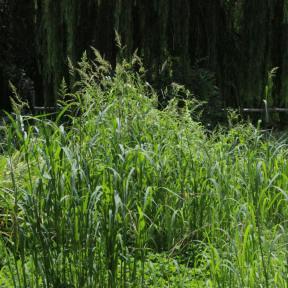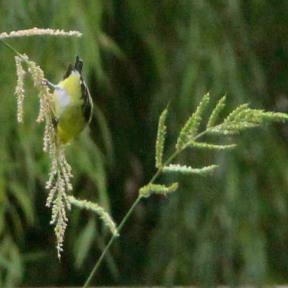Weed No. 5. Barnyard Grass (Echinochloa crus-galli)
Farmers detest this European grass for its ready invasion of most crops. The plant can invade and destroy native grassland vegetation. This appears to be true only of areas disturbed by grazing livestock. Otherwise, Barnyard Grass serves as a colonizer and successional species that is steadily replaced by longer-lived species. In one research study, other species replaced it in about 10 years.
In the arid climate of central Arizona, the plant survives only along moist stream banks and in bare spots in and beside watered lawns and gardens. Here, the plant is easy to control by mowing or withholding water. However, if you allow a few clumps to grow, you will get to enjoy watching the acrobatics of Lesser Goldfinches that relish Barnyard Grass seeds. The small birds hang (often upside down) on drooping seed tops steadily removing mature seeds until all are gone. The birds must drop some seeds, however, as new plants appear in the same spots every spring.



Barnyard Grass (Echinochloa crus-galli). This strong summer annual matures at ½ to 6 feet tall and often spreads from its base to form large clumps. The leaves are 4 to 20 inches long and ¼ to ¾ inches wide. Flowering occurs along the top 3 to 10 inches of the stem. Flowering branches are 1 to 2 ¼ inches long with short green or purple spikelets 1/8 inch long with bristles up to 1 ½ inches long. A single plant can produce 40,000 of the pale yellow shiny seeds. A. Spikelet spread open. B. Two spikelets with short and long awns. C. Grain. Image used with permission of the University of Arizona Press.

